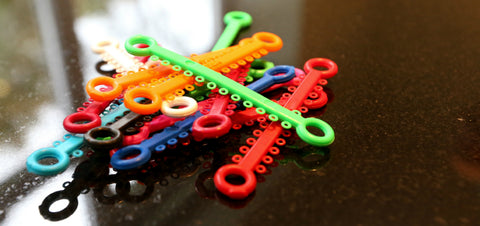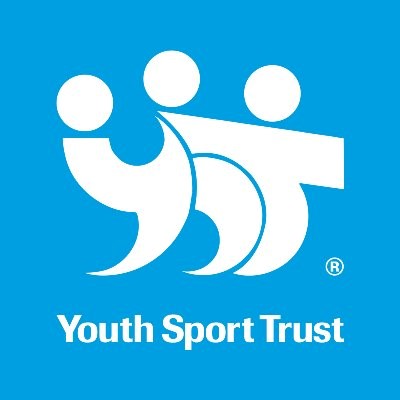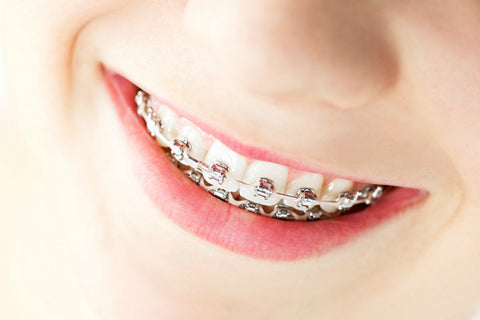What You Might Have Missed from the Northenden House Blog! 0
As a dedicated orthodontic practice the team at Northenden House always strive to deliver the best customer care, providing patients with their expert tips and advice on orthodontics and the latest in the industry.

This year we’ve aimed to share key news and guidance with you on our blog, whether you’re considering teeth straightening options, are undergoing orthodontic treatment or simply want to improve your oral health.
As we’re now just over halfway through, we thought we’d round-up some of our top blogs from the year that you may have missed:
Improving your smile with orthodontics
At the start of 2016 we looked at working on those New Year’s resolutions, and how transforming your smile can greatly improve your confidence. Research has shown that the smile is deemed one of the most attractive and first-noticed features of a person, however many adults are self-conscious of their teeth and lack the confidence to smile or laugh in the company of others.
In our blog promoting a ‘new year, new you’, we detailed the variety of treatments to help you get the smile that you desire, from hidden braces to clear aligners.
How can orthodontic treatment benefit children?
Having a great smile through teeth straightening orthodontics can make a lasting difference to a child’s self-esteem, as well as their overall health. But as a parent you may be concerned about what age your child should have orthodontic treatment, what type of treatment will be best for them and what’s involved.
The help of celebrities and social media are making dental braces more popular
Despite being very effective we know that traditional metal braces have never been a massively popular thing – in fact many adults chose not to wear braces as teens through fear of being seen as a ‘metal-mouth’.
Luckily though nowadays dental braces are much less bulkier and a good deal more comfortable. And the number of people opting for braces has significantly grown with the help of celebrities and advocacy on popular social media sites. We report on the growing trend of people sharing their orthodontic journey online, and how one celeb in particular made dental braces seem a lot more viable for adults in the UK.
Looking after our oral health – National Smile Month
From the 16th May to the 16th June, The British Oral Health Foundation ran its annual National Smile Month campaign, aiming to increase awareness of oral health and get us smiling!
We provided some top tips on looking after your oral health, including maintaining a good oral routine and teeth-friendly diet.
How to take care of your braces on holiday
If you’re undergoing orthodontic treatment and will be going on holiday this year, you can still relax and fully enjoy your time away. However, it’s always best to be prepared, and by reading our blog you’ll be able to know what to take away with you to keep your braces, teeth and gums in top condition, as well as what to do should your braces become damaged.
If you’d like any more guidance or to speak with one of our expert orthodontists, call us on 0161 998 2622, email info@manchesterorthodontics.co.uk, or alternatively use our online contact form and we’ll get back to you as soon as we can.
- Blue Horizons
- Tags: brace care children's orthodontics oral health Orthodontics
Holiday Care for Your Dental Braces 0
The summertime is here which means that many of us will be packing our suitcases and jetting off to more exotic locations. However, though your holiday is a chance to take a well-earned break from your day-to-day home life, it doesn’t mean you can take a break from your braces.
The temptation may be there, but it’s important to take the proper care of your braces wherever you may be - after all they’re an investment to help you achieve the perfectly straight and healthy smile you want! Not taking the proper care could prolong your treatment time
Additionally, you may not have access to your orthodontist or orthodontic provisions should a problem arise with your braces or oral health, so it’s best to make sure you’re prepared before you travel. Here are our top tips on what to do if you’re going away and how to take care of your braces and oral health:
Your holiday orthodontic packing list

There are a few essentials you’ll need to pack to take away with you. Be sure to keep these wherever you go on your holiday, in a waterproof bag if you’ll be by the pool or on the beach:
- A travel-sized toothbrush
- Orthodontic wax to help with any discomfort from your braces
- Travel-sized mouthwash
- Dental floss
- A compact mirror to help resolve any issues
These items will help you keep your teeth clean and your braces in top condition throughout your holiday. However, it’s a good idea to be careful about what you eat to avoid any potential damage to your brackets and wires which will be difficult to manage whilst away.
Your orthodontist should have advised you on the certain foods that should be avoided whilst wearing braces, such as hard foods like nuts or raw vegetables, and chewy or sticky foods like caramel or sweets. Being sensible whilst you’re on holiday will minimise the risk of damaging your braces as you may not be able to get them fixed immediately.

If anything should happen to your braces whilst you’re away, you’ll need to visit your orthodontist as soon as possible in order to get them repaired. If you’d like any more advice on caring for your braces, you can call the Northenden House practice on 0161 998 2622 or email us at info@manchesterorthodontics.co.uk. Alternatively you can use our simple online contact form and we’ll get back to you as soon as we can.
- Blue Horizons
- Tags: brace care oral health Orthodontics traditional braces
National School Sport Week – Looking After Your Teeth and Braces Whilst Playing Sports 0
National School Sport Week, running from the 20-24th June, is an important event inspiring children’s health and wellbeing. Organised by the Youth Sport Trust, this year’s event is based around the Rio 2016 Olympic and Paralympic Games, encouraging pupils to be more active and take part in more PE and school sport.

Playing sports and healthy teeth
Studies have found that people who maintain a healthy weight and have high levels of physical fitness, have a lower occurrence of gum disease. It’s a major cause of tooth loss in adults, and research suggests that it’s linked to health problems such as heart disease and diabetes.
So, it’s important to ensure that from a young age people are aware of the overall health benefits of staying active, which National Sport Week hopes to achieve. However, for children wearing braces, it may be more difficult to participate in sports and in fact some physical activities could damage the health of their teeth and gums.
The dangers of wearing braces and playing sports
It’s been reported that between 13% and 39% of all dental injuries are sports related. Contact sports in particular, can be dangerous for children wearing either fixed or removable braces. The metal appliance could cut the mouth with impact, or impact from contact or a fall could lead to trauma of the teeth and mouth.
To avoid damage to the brace, or worse injury to the mouth, there are a few measures that children can take whilst participating in school sports and physical activities:
Wearing a helmet
For contact sports or activities where there are high speeds or impact, such as hockey, skating or cycling, wearing a properly fitting helmet with protective caging will prevent trauma should the pupil be knocked or fall over.
However, if a helmet is not an option, protective mouthguards are essential to protect a child’s braces and mouth, and ensure that their orthodontic treatment can be carried out smoothly and efficiently.
Wearing a mouthguard
Although wearing braces can actually help support the teeth during sporting activities, wearing a mouthguard over them will protect the appliance itself and the mouth. Damaging the brace could prolong treatment time or cause injury in the mouth, making it important to protect it and seek orthodontic help straight away should damage occur.
A mouthguard is made from an odourless, tasteless and pliable material, such as polyethylene vinyl acetate (pEVA). It’s a non-toxic plastic which should be of sufficient thickness and impact absorbing, providing resistance to abrasion. Mouthguards are made to be durable so that they can last at least a whole season of sports competition and training. Braces wearers playing sports can either get custom-made mouthguards or ‘ortho-guards’ can be bought ready-made from sporting stores.
- Custom mouthguards can be made by your orthodontist, fitting to the contours of the teeth and offering great protection for the gums, tongue and mouth during sporting activities.
- Ready-made, ‘boil-and-bite’ mouthguards can be shaped to fit the wearer’s braces by being softened in boiling water and shaped. This allows the guard to be remoulded as the teeth move throughout treatment.
Any mouthguard worn should fit well, be comfortable and not dislodge on impact. For those wearing removable braces, it’s still best to wear a mouthguard whilst keeping the appliance in a brace case. Your orthodontist will be able to advise on the most suitable mouthguard, how to take care of it and how often it will need to be replaced.
If you’d like more advice on wearing braces and playing sports, or for any help with brace care, please contact our Manchester practice on 0161 998 2622, or email the Northenden orthodontic team at info@manchesterorthodontics.co.uk.
- Blue Horizons
- Tags: brace care children's orthodontics national sport week Orthodontics
What Are the Long Term Benefits of Introducing Orthodontics From an Early Age? 0
Although the common age to begin orthodontic treatment usually comes at the start of patients’ teenage years, introducing orthodontics from an early age could greatly reduce the need for more extensive and costly work further down the line. In fact a recent study from the American Journal of Orthodontics & Dentofacial Orthopedics, reports that many young children may benefit from orthodontic correction from as young as 6 years old.

The first permanent adult teeth will appear in children of around 6 years, just before their first baby teeth start to fall out. A lot of children will grow into their adult teeth without any trouble, however there are a few problems that can occur as the new teeth start to come through:
- Teeth can protrude out significantly, which can be exacerbated by thumb sucking from an early age
- A lack of space for the new teeth may lead to overcrowding and a misaligned bite
- There may also be too much space for the new teeth, called the ‘ugly duckling’ stage of development. Excess space usually closes with growth, though this is not necessarily always the case
- There may be a retention of the baby incisors, which can prevent the adult successors from coming through or lead them to develop over them
The study looked at the potentially damaging effects of protruding teeth in children from the ages of 6-10. It found that almost a third of children who were treated for severely protruding teeth were less likely to experience dental trauma, such as a chipped, broken, or knocked out permanent tooth.
As many children are highly active and enjoy sports or activities where there’s a higher risk of trauma, it’s advised that those in particular with severely protruding teeth, should visit their orthodontist early on. Not only will this reduce their risk of injury, it will also help to guide their teeth into a healthier position and could prevent the need for further orthodontic treatment when they’re older. In addition, in this early stage where children can be sensitive, having orthodontic treatment can help them to feel more confident in their smile as they grow.
Early Orthodontics – What Are the Options?

There are three main types of orthodontics suitable for children from a young age:
Preventative orthodontics
Preventative treatment can help avoid a malocclusion from developing due to spacing issues – tooth crowding or a misaligned bite. Here an orthodontist will be able to create enough space for the permanent teeth to come through normally. A common method is using a space maintainer.
Interceptive orthodontics
For children from the age of 6 years, visiting an orthodontist can catch problems early on before they develop into more severe dental issues. The risk of protruding teeth, especially through thumb sucking, can be corrected and reduce the need for later comprehensive orthodontic treatment. Permanent teeth can also be guided into the correct positions through tooth removal or size adjustment.
Comprehensive orthodontics
This is the typical treatment that teenagers receive to align the teeth and bite, however carrying out necessary comprehensive orthodontics from an early age, will again help to reduce the need for more complex and long-term treatment when they’re older. Children can have treatments including wearing realigning headgear or having fixed retainers to help close gaps and align their new adult teeth.
If you’d like to find out more about orthodontics for children, or to discuss your child’s orthodontic treatment, you can call the Northenden House team on 0161 9982622, or contact us here to book your initial consultation.
- Blue Horizons
- Tags: brace care children's dental care children's orthodontics Orthodontics
How Orthodontic Treatment Can Benefit Your Child 1
Children and teenagers can often be more easily affected by first impressions and especially conscious of their own. Having a great smile can make a lasting difference to their self-esteem, as well as their overall health. That’s why orthodontic treatment is such an important consideration for your child, so that they can feel confident and happy in their smile and the first impressions they’ll make. But at what age should you consider your child’s orthodontic treatment, what type of treatment will be best for them and what will it involve?
When to take your child to the orthodontist
There are different phases for orthodontic treatment; Phase One occurs when the child is around the age of eight or nine, known as early treatment. The second phase will take place for children from around the age of eleven, into the teenage years. Although currently, most children receive treatment when they’re around twelve years old, earlier orthodontic treatment can save a lot of time, money and inconvenience when it comes to Phase Two.
In fact, health bodies such as The American Association of Orthodontists, advise that children go for an orthodontic screening as early as seven years old. This way, an orthodontist can look for potential problems with jaw alignment and bite as they grow. An early examination can also help find extrusions which are likely to create spacing problems, if all the adult teeth haven’t come through. You’ll then be advised on the best solution for your child, or whether they’ll need future treatment at all.
Why your child might need orthodontic treatment
Overcrowded, crooked teeth, or a misaligned bite, though common in children and teenagers, can not only lead to poor oral health and wear or damage the teeth, they can also place pressure on the jaw and cause irregular growth – changing the facial structure. One of the factors that can contribute to orthodontic problems in children is thumb sucking, as it can cause the lower teeth to become set back or the upper teeth to protrude forward. Early intervention, therefore, is sometimes necessary to prevent enduring tooth and jaw problems. Orthodontics is most effective at an earlier age, before a child’s jaw stops developing, which is usually towards their adult years. Signs that your child may need orthodontic treatment include:
- If your child continues thumb sucking after 5 years of age
- Lisps or speech impediments
- Teeth are protruding, or don’t come together normally
- Crowding of the front teeth begins at around the age of seven or eight
- Your child has difficulty chewing or biting
- A shift in the jaw when they open or close their mouth
- They are breathing through their mouth
Phase One treatments in most cases begin once all of the adult teeth have started to come through and use methods and appliances to correct the position of the jaw and dental arches. If your child’s orthodontist sees that teeth coming through will likely cause crowding or other issues, they can use interceptive orthodontics to shift the size of the dental arch for better teeth positioning. This will decrease the likelihood of teeth having to be removed or additional orthodontic treatment as your child reaches teenage years, however Phase Two treatment is usually still needed. The future treatment will mostly be a lot shorter and less expensive though.

How an orthodontist can help improve your child’s teeth
Investing in orthodontic treatment for your child at an earlier stage, can prevent them needing it when they’re an adult, where it often takes longer and surgery may have to be involved. If you’re considering orthodontic treatment for your child, here are the problems it can help to correct:
- Orthodontics for your child can help to correct protruding upper front teeth, improving oral health, the appearance of the teeth, as well as reducing the risk of traumatic injury to the upper teeth.
- Crowded or asymmetrical teeth can be straightened and guided into a healthier position by creating space for teeth to grow. This will also help to correct damage to the teeth and shifting of the jaw over time.
- Incorrect bites can be corrected as orthodontics will guide the growth of the jaws, reducing the chances of abnormalities.
Most treatment will involve the use of braces, which are extremely effective and are much more comfortable and smaller than previously. You can check whether your child is permissible for free NHS orthodontic treatment, if they’re under the age of 18. At Northenden House Orthodontics we offer a wide choice of treatment options for children and can carry out treatment from NHS referrals. If you’d like to speak to us regarding treatment for your child, or to book your consultation, please contact the practice on 0161 998 2622 or email info@manchesterorthodontics.co.uk.
- Blue Horizons
- Tags: brace care children's dental care children's orthodontics Orthodontics traditional braces

